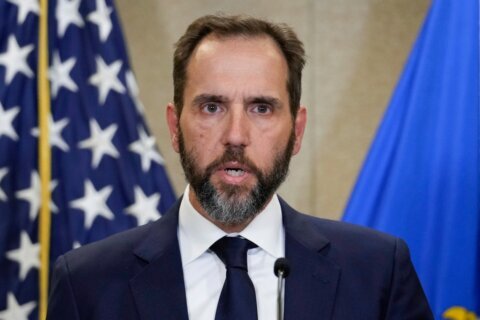LONDON — Much of the developed world has enjoyed increasing life spans for many decades, thanks to a variety of factors, including reductions in smoking, less pollution and major improvements in medical care — particularly advances in treatments for cancer, infections and heart disease. And that certainly has been the case for the United Kingdom, where gains in life expectancy advanced unabated for nearly 130 years.
Until now.
The growth in life expectancy in the nation ground to a halt, according to figures recently released by the U.K.’s Office for National Statistics, or ONS.
And the most likely cause for the stall, many public health experts say, is the austerity budgets enacted by three Conservative-led governments since 2010, initially in response to 2008’s Great Recession. The ongoing squeeze on national spending led to cuts in social and health care services, as well as other benefits and services that the elderly — especially the poorest among them — rely on for good health.
“It’s very difficult to say one thing causes another,” says Lucinda Hiam, a physician and honorary research fellow at the London School of Hygiene and Tropical Medicine. “However, the evidence (pointing to cuts in services) is really building, and these latest statistics really confirm our repeated concerns.”
The slowdown in life expectancy began in 2011, after years of strong growth, says Martin McKee, a professor of European Public Health, also at LSHTM. He’s been gathering evidence since 2014 that indicates the reductions in services and benefits to the elderly are increasing mortality rates in some age groups. “When you look at all the possible causes, you’ve got to be careful drawing conclusions, but the only one that makes any sense is that austerity must have played a role.”
[MORE: These countries are viewed as offering the best quality of life.]
Elizabeth Webb, a senior researcher at AgeUK, Britain’s largest charity for the elderly, says her organization sees many people not receiving social services they need. “It’s hard to say as yet this is impacting their life spans, but there are strong indications that it’s likely.” Spending for preventative services has been hit badly, for example, Webb says, which means that more people are now ending up in care facilities earlier than they might otherwise have, and in worse shape.
The life span data in the U.K. resonates beyond that country’s borders, as developed and wealthy nations confront aging populations and growing budgets for social services. In the U.S., Republican leaders in Congress blame entitlements for the soaring national debt, a claim many economists dispute. Life expectancy in the U.S. has actually dropped for two straight years, according to the most recent report from that country’s National Center for Health Statistics.
In the U.K., the ONS, which has been collecting and reporting data on life spans since 1980, says life expectancy at birth in the U.K. stopped improving between 2015-17, peaking at 82.9 years for females and 79.2 for males. The independent government agency also cites other sources that show life spans in Britain have been increasing since 1890. Additionally, ONS says, remaining life expectancy from age 65 for both sexes also stalled for the first time. Indeed, the slowdown in mortality improvements affected all age groups, while in the recent past it was mainly centered on those over 75.
The U.K.’s life expectancy figures are also worse than those of many other leading countries, including Switzerland, France, Japan and Spain, the ONS says. However, Sophie Sanders, an ONS senior research officer, says that several other developed countries also recently experienced a slowdown in life expectancy, although it’s been more pronounced in Britain and the U.S.
While officials cannot rule out austerity budgets contributing to the pause in life expectancy, Sanders says the data available neither confirms nor rules out such a conclusion. It’s possible, for instance, that the benefits from health care improvements have peaked, she says. The ONS also says that a particularly bad flu season during the period may have contributed to the stall.
[MORE: 10 countries seen to have the most well-developed public health care systems.]
Some researchers question whether the benefits of better health care are plateauing, given that in several industrialized countries, mortality rates are falling. As for influenza, McKee admits it could have been a factor. But, he adds, only a small percentage of people who get flu die, and it’s also possible that service cuts made those who did die more vulnerable to the disease.
There’s no question that the spending squeeze has had a deleterious effect on health and social services. A year-old report compiled by several health care consultancies noted that tighter budgets and increasing demand were harming patient care in the National Health Service, and that the amount the government budgeted to spend on the NHS this year fell short of what was needed to meet rising demand and maintain standards of care. This year, the NHS budget was boosted by only 0.4 percent, one of the lowest increases in its history. Meanwhile, since 2010, spending on social services in England fell by 7 billion pounds ($9 billion).
Two years ago in its annual report, the Care Quality Commission, the U.K.’s health and social services regulator, said that cuts in at-home care services and a reduction in beds in care homes were forcing hospitals to admit more elderly people as patients on an emergency basis, making many of them dangerously full. This year’s report, released earlier this month, reported that the number of older people in England not getting essential care and support hit a high of 1.4 million, an increase of 19 percent since 2015.
Reductions in those and other services affect the lives of the elderly on many fronts, however, from worsening nutrition to lack of mobility and increased stress. “Health is influenced by more than health care,” Hiam says. “It’s impacted by the social determinants of health; that is the conditions we are born, live, work, grow and play in. These are all impacted by austerity.”
For instance, there have been reductions in rural bus services across the country, and Meals on Wheels food deliveries have halted in some districts. The consequences of those cuts can leave many impoverished older people feeling increasingly isolated, Hiam says, adding that for some of them, a daily visit by a Meals on Wheels volunteer helped reduce loneliness and isolation, as well as the risk of malnutrition.
So has life expectancy in the U.K. reached a dead end?
Earlier this month, Prime Minister Theresa May announced the end of austerity budgets. If she keeps that pledge, it could mean more money for services that aid the elderly, which could help rejuvenate longevity rates.
However, Brexit — the U.K.’s upcoming divorce from the European Union — also looms, and it could be a factor, too. During the past 20 years, the U.K. experienced a large influx of young workers from Eastern Europe whose overall good health may have masked a worsening trend within the native population, McKee says. The number of EU migrants allowed into Britain will likely be severely cut after Brexit, and many already living here may decide to leave — developments that could adversely affect mortality rates.
“You have reason to wonder,” McKee says, “if things will get worse.”
More from U.S. News
The 10 Most Health-Conscious Countries in the World, Ranked by Perception
Countries Seen to Offer the Best Quality of Life
Learn More About the United Kingdom
Life Expectancy Stops Growing in the U.K., Puzzling Health Experts originally appeared on usnews.com







